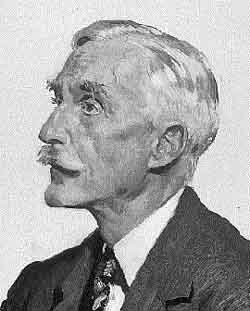 Andrew W. Mellon
(1855-1937)
Andrew W. Mellon
(1855-1937) Andrew W. Mellon
(1855-1937)
Andrew W. Mellon
(1855-1937)
By Richard Sanders, Editor, Press for Conversion!
Mellon is known to have donated at least $1,000 to the American Liberty League.
Most prominent among the Mellon family supporters of the American Liberty League was Andrew Mellon. Perhaps only the son of a banker, like Andrew, could start a successful lumber business at age 17. He then work-ed in his father’s bank (T. Mellon & Sons) and started building his fortune in oil, steel, shipbuilding and construction. By 1914, he was one of America’s richest men. He was a trustee of the Carnegie Institute, 1924-1937, a long-time activist in the Republican party and one of its top donors.
Mellon was not fondly admired, except by the extremely rich, for his role as U.S. Secretary of the Treasury under Presidents Harding, Coolidge and Hoover (1921-1923, 1923-1929, 1929-1932). His main accomplishments were reducing taxes for the rich and cutting government spending to social programs. Sound familiar? In 1921, the Revenue Act saved corporate stockholders about $1.5 billion by eliminating the excess profits tax. As a result, U.S. Steel got $27 million and the Mellon Bank got $91,472. The biggest beneficiary was John D. Rockefeller, who received $457,000. Mellon himself got the second biggest rebate, $404,000. In 1923, the “Mellon Plan” proposed that taxes paid by the country’s eltie should be reduced from 50% to 25%, while taxes paid by those with the lowest incomes would be reduced from 4% to 3%. If passed, this would have cut his own taxes by $800,000. By 1926, Mellon finally succeeded in slashing the elite’s taxes and, in 1928, he got a law to cut corporate taxes even more. At that time, the top 10% received 50% of the country’s total income, while the top 1% received 24%. Under Mellon, corporations got tax rebates of $6 billion, and those with incomes over $300,000 had taxes reduced by 60%. This led to increased stock market speculation and contributed to the 1929 crash. Mellon also gave secret tax cuts to huge corporations that were owned by him, his family and friends. Congress eventually demanded his impeachment, he resigned in 1932, became Hoover’s Ambassador to the Court of St. James, i.e. Britain, and retired from politics the next year.
Mellon’s wealth was tied up in the Mellon National Bank (one of America’s largest), Carborundum (now Uni-frax, a leading industrial insulation producer), Koppers (a top global producer of naphthalene and coal tar), Gulf Oil and the Aluminum Corp. of America (ALCOA). ALCOA’s trade with the Nazis, through a cartel with I.G. Farben, sabotaged U.S. military access to aluminum. In 1943, anti-fascist journalist, George Seldes, said ALCOA was “largely responsible for the fact America did not have the aluminum with which to build airplanes before and after Pearl Harbor, while Germany had an unlimited supply” (Facts and Fascism, 1943). In 1941, Secretary of the Interior Harold Ickes had warned: “If America loses the war it can thank the Aluminum Corporation of America.”
During WWII, Andrew’s son, Paul Mellon, was station chief for the Office of Strategic Services in London and liaison to British intelligence. In Acid Dreams, M.A. Lee and B. Schlain note that “After the war, certain influential members of the Mellon family maintained close ties with the CIA. The Mellon family foundations have been used repeatedly as conduits for Agency funds.”
Another Mellon family member with CIA connections was Billy Mellon-Hitchock. Known as “the Daddy Warbucks of the Counterculture,” he was Timothy Leary’s “Godfather.” In the early 1960s, Mellon-Hitchcock financed the mass-production and distribution of LSD, which was then undergoing testing through the CIA’s MK-Ultra program. Mellon-Hitchcock’s funding was done through the Castle Bank of the Bahamas, an institution founded by Paul Helliwell, paymaster for the CIA’s failed Bay of Pigs invasion and boss of Watergate burglar E. Howard Hunt.
The Andrew W. Mellon Foundation’s market value in 2003, was $3.6 billion (down from its peak of $5 billion in 2000). It disburses about $200 million per year.
References:
David Cannadine, "About Andrew W. Mellon" and Andrew
W. Mellon Foundation, Annual Report, 2002.
http://www.mellon.org
Mellon, Andrew William
http://politicalgraveyard.com/bio/mellette-memorial.html
Howard Zinn, People's History of the United States, 1995.
Steve Brouwer, Robbing Us Blind: The Return of the Bush Gang
and the Mugging of America, 2004.
http://www.thirdworldtraveler.com/Bush_Gang/StealingLivelihood_RUB.html
John B. Judis, The Paradox of American Democracy, 2001.
http://www.thirdworldtraveler.com/Democracy_America/DevelDemoPlural_POAD.html
Linda Minor, Follow The Yellow Brick Road: From Harvard To
Enron (2002)
http://www.newsmakingnews.com/lm7,1,02,harvardtoenronpt5.htm
History of the Treasury, Secretaries of the Treasury, Andrew
W. Mellon
http://www.ustreas.gov/education/history/secretaries/awmellon.html
"VAST Right-Wing Conspiracy"
http://www.umsl.edu/~skthoma/mah7.htm
Source: Press for Conversion! magazine, Issue # 53, "Facing the Corporate Roots of American Fascism," March 2004. Published by the Coalition to Oppose the Arms Trade.
Order a Copy: Order a hard copy of this 54-page issue of Press for Conversion! on the fascist plot to overthrow President F.D.Roosevelt and the corporate leaders who planned and financed this failed coup.